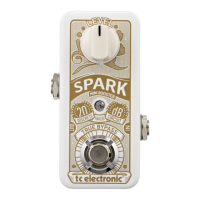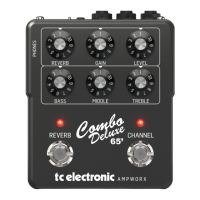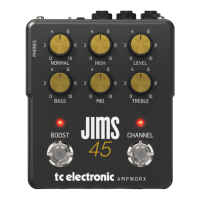Chapter 2: Individual Parameter-Access 3
2 Individual Parameter-Access
2.1 Overview
Each individual parameter in the M5000 has a unique ID. This gives you access to each parameter in
each algorithm and general system-parameters, such as Input-gain or Bypass, for instance.
Not all parameters exist at the same time. For example, parameters in the REVERB-3 algorithm
don’t exist if a PITCH-1 algorithm is running on the DSP-card in question. Trying to set nonexistent
parameters will have no effect, and requesting their setting will produce no result.
Note: It is possible to obtain information about the algorithm currently running, to determine which
parameters should be polled. Please refer to Chapter 0 for a description of how to obtain information
about the algorithm currently running on a DSP-card.
2.2 Parameter-IDs and Values
All parameter-IDs and values in the M5000 are 14 bit wide. In addition, parameter-values are signed,
to allow for negative values. The two ranges are as follows:
Parameter-IDs: 0 to 16383 ($0000 to $3fff)
Parameter-values: -8192 to 8191 (-$2000 to $1fff)
2.2.1 Parameter-IDs
In the following documentation, the 14-bit parameter-IDs are shown as <Par# xxxx>, although their
physical placement in the sysex-packet is as follows:
Par #xx__ bit 8-13 (MSB First)
Par #__xx bit 0-7 (LSB Last)
...is shown as:
<Par #xxxx>
In sections 0 and 0 you’ll find two C-routines that convert the two MIDI-bytes to a single C-type
unsigned short and vice versa.
2.2.2 Parameter-values
In the following documentation, the 14-bit signed parameter-values are shown as <Value #xxxx>,
although their physical placement in the sysex-packet is as follows:
Value #xx__ bit 8-13 (MSB First, sign in bit 13)
Value #__xx bit 0-7 (LSB Last)
...is shown as:
<Value #xxxx>
In order to convert these double MIDI-bytes to a single C-type short, the sign bit must be extended
from bit 13 to bit 15. In sections 0 and 0 you’ll find two C-routines that convert the two MIDI-bytes
to a single C-type short and vice versa.
2.3 Requesting Parameter Values
The following sysex-packet allows you to request the setting of a number of parameters. In a single
packet, you can request as many or as few parameters as you like.

